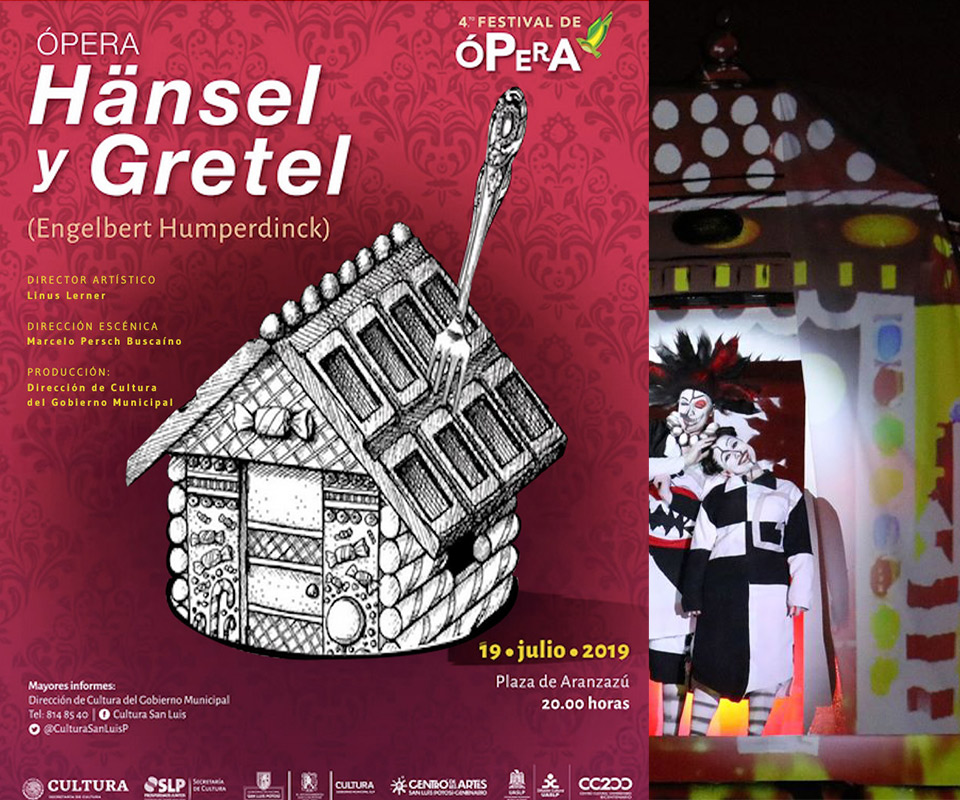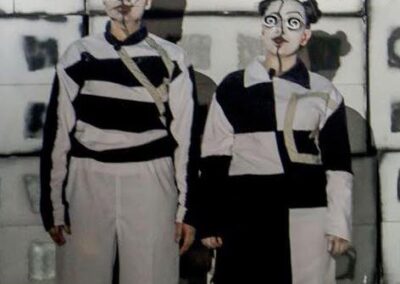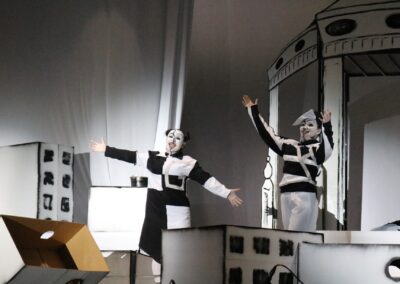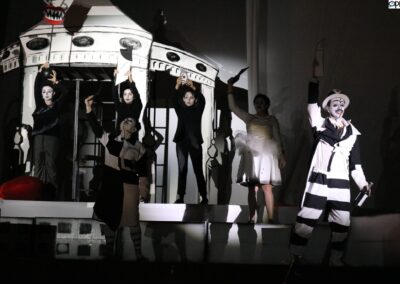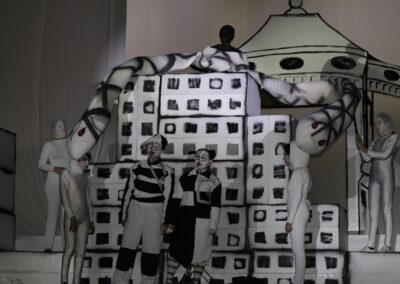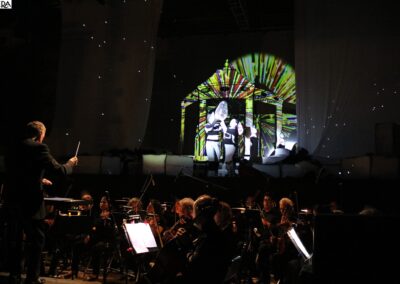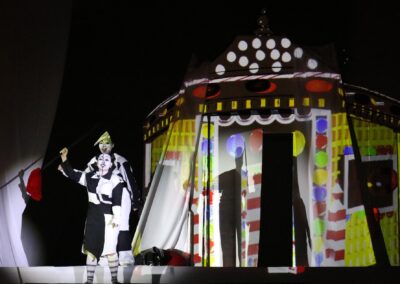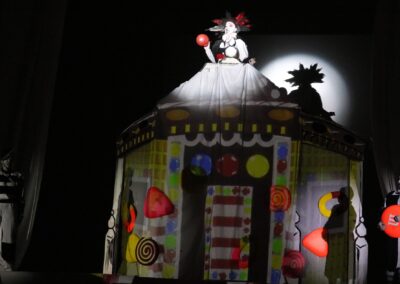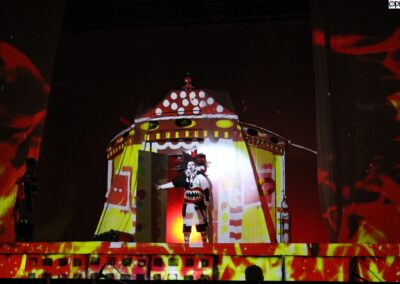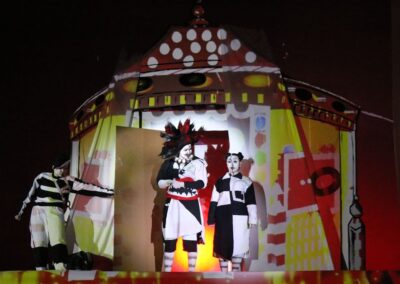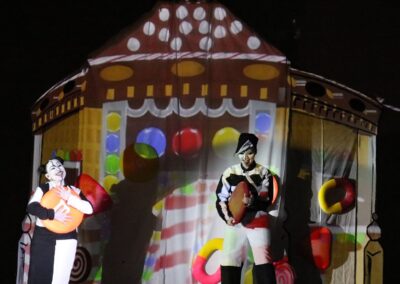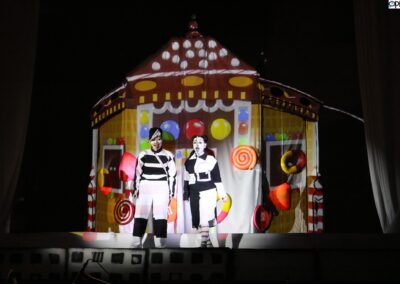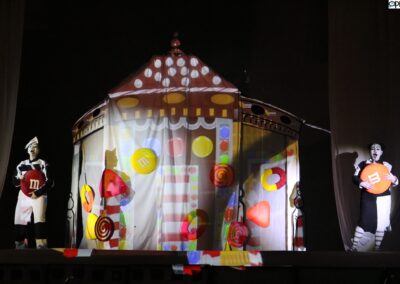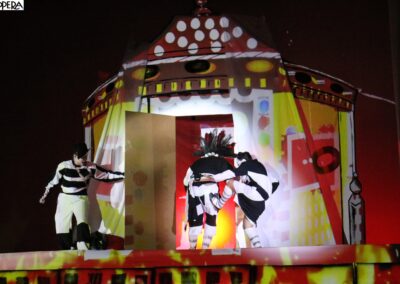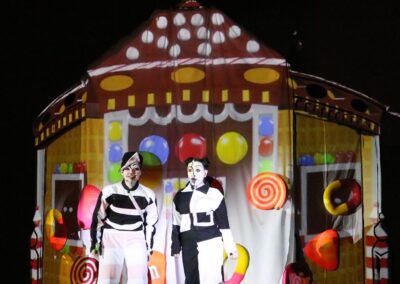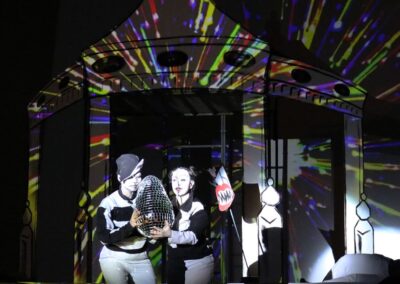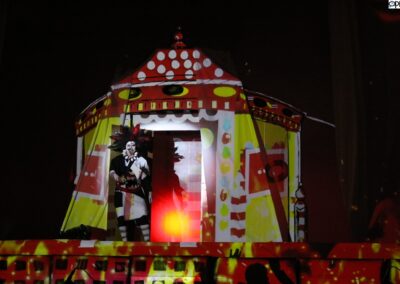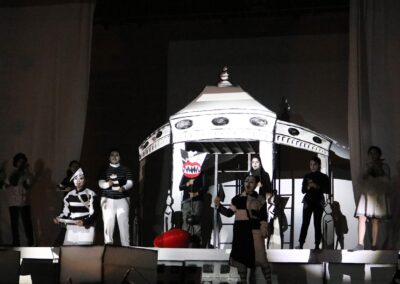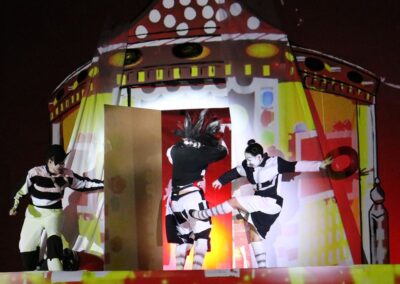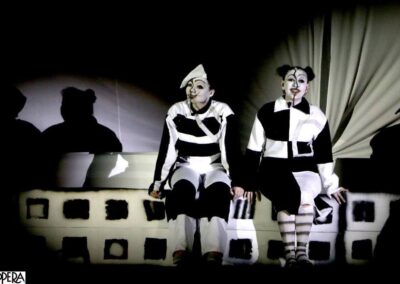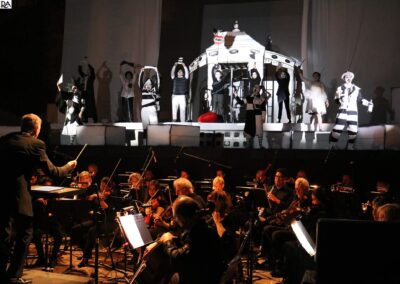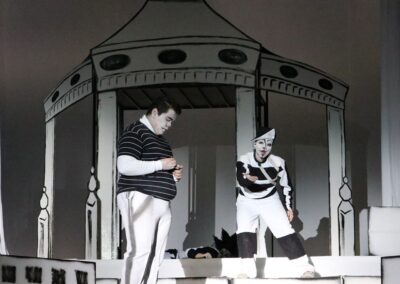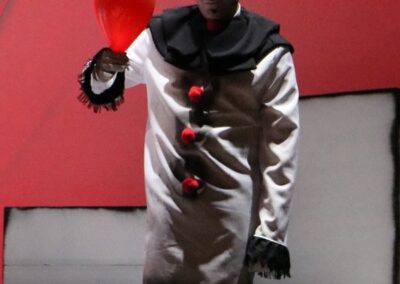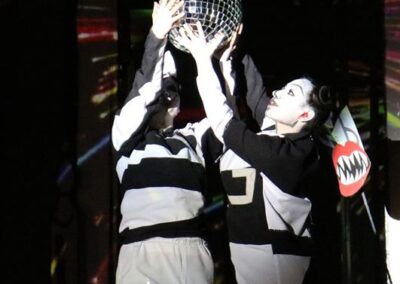Hänsel und Gretel
The year after « Così Fan Tutte », I was asked to stage « Hänsel und Gretel ». In addition to the challenges that already existed in « Così Fan Tutte » – very few funds, a 10-day rehearsal time in a space that had nothing to do with the real space of the real stage and the lack of a professional production team – there was an added difficulty: the show would be outdoors!
The festival Director initially considered using the music kiosk in the main square of San Luís Potosì as a stage. She then transferred the project to a large wooded park, which would serve as the forest in which Hänsel and Gretel get lost. Finally, another square in the city center – surrounded by magnificent colonial buildings in bright colors – was chosen as venue.
From the first location, I retained the kiosk as a base idea. From the second, I imagined that the only thing that could contrast with the lush vegetation of the park would be something artificial like a complete scenography in black and white with occasional elements in red – only this kind of scenography would also be able to attract the focus of spectators’ attention amid the brightly colored colonial buildings of the third and final location. Additionally, in order to create something unusual in the context of the urban landscape, I decided to use video projections.
The musical kiosk in the central square of San Luís Potosì houses families who live there in precarious situation and who sleep on cardboard boxes; some parents seek alcohol as an escape from the poverty in which they find themselves, while many of the children beg or commit petty theft… I seemed to find a clear parallel between this and the initial situation of hunger, misery and violence in the first part of the opera, with a violent and abusive mother and an alcoholic father. Therefore, I initially thought about creating a realistic production that directly represented this reality, but the festival management demanded that it be a fairy tale.As I didn’t want to abandon my initial idea, I chose to do it with a surreal language – which also characterizes many aspects of the local imaginary. To achieve this, I made all the scenic elements two-dimensional/schematic representations of real elements, as if taken from children’s drawings: the music kiosk was done exactly that way. Also distributed on the scene were several reinforced rectangular cardboard boxes, painted white and with black edges – large “Lego” pieces, whose position was being changed to create new scenic spaces – thus also using a child-based aesthetic.
A historical coincidence made this surreal aesthetic confirm itself as the identity of my reading of this play: the year of composition of « Hänsel und Gretel » (1893) was the same year in which Freud established the foundations of what he called « Subconscious », whose mechanisms permeate, in turn, the functioning of dreams, which Freud later dealt with in « The Interpretation of Dreams ». Furthermore, for the Huichol, an indigenous Mexican ethnicity who migrate through the San Luís Potosì region, dreams have a primary function: in them, one looks for the blue deer – a sacred figure that purifies the dreamer and that reveals one’s mission in life! Therefore, dreams became a special theme in the interpretation of this opera.
Like the scenography, costumes were also characterized by being pseudo two-dimensional, in black and white, with details in red. Each of them had symbolic/surreal elements. Perhaps the most emblematic of all was that of the witch: it resulted from a mix between the figure of the father and the mother, which, in psychoanalysis, embody refuge, desire, but also fear and the lack of love from those who we most desire to love us.
In the ouverture, a young kid’s depiction of daily life in a small town is represented in front of the curtain. The curtain then opens for the inauguration of the music kiosk by local authorities.The overture ended with a group photo of everyone in front of the new kiosk. After photographing those in the scene, the photographer turned to the audience and photographed them.
In the first part, Hänsel and Gretel played with cardboard boxes, interacting with various passers-by. The game is then brutally interrupted by the mother who, coming from inside the kiosk, wakes up from her alcoholic dream and ends up forcing the children to go out to find food. Soon after, the father arrives, also somewhat drunk, celebrating the fact of having done good « business ». The mother then tells him that the children have left for the jungle…
The jungle that Hänsel and Gretel face does not consist of trees, but rather of cement: the big city to which many abandoned children in Mexico migrate to, in order to look for a better life. To represent it, the « Lego » pieces are stacked, thus forming children’s skyscrapers. In this new environment, Hänsel and Gretel apply the same tricks to survive: they create distraction maneuvers in order to carry out small thefts. The arrival of night in the big city, however, brings them a lot of fear. At this moment, a surrealist element intervenes: the spirit of sleep (Sandmännchen: little sand man in the original) is represented as a large snake – including the hissing sound it produces – which ends up biting them (in an allusion to « The Little Prince »), causing them to sleep.
At this moment, dreaming, represented by the video projection, begins. Initially, in black and white, it evolves into a world full of colors, where Hänsel and Gretel find the witch’s house, which is nothing more than the kiosk superposed by the colorful and changing images of the mapping. The three characters move in it accompanied by three follow-spots. When the oven explodes, the projection also does it and everything goes back to the way it was in the first scene. This colorful scene was merely a dream, from which Hänsel and Gretel are awakened by their father’s voice that brings them back to their black and white reality.
Upon awakening, however, they find the witch’s body transformed into a cake; passers-by and Hänsel and Gretel’s parents start devouring it in an almost cannibalistic way, fighting violently among themselves to see who gets the biggest piece… Meanwhile, on the two-dimensional kiosk, the real image of the symbol of the city of San Luís Potosì – a baroque-style water tank – is projected with its occasional passers-by. Stunned, Hänsel and Gretel watch as the world around them succumbs to violence and toxicity. They discover though a remnant of their dream: a confetti (like a giant M&M), whose surface layer they remove, revealing a mirror egg that diffuses/reflects/refracts the light that is projected onto it – a symbol of something new, ofa new consciousness. They may have found their mission/purpose in the dream they had.
Projected in the supertitles, I used texts/questions that deal mainly with the function of dreams and with responsible parenthood, which are two essential themes for me in Hansel und Gretel.
Some of the questions were: what do we want for our children? What would you do if your son or daughter wanted something different for themselves than you want for them? What is the price you are willing to pay to feel loved? Is it easy to be your father, to be your mother? What did you dream about when you were a child? Who is the witch?
Among the texts, I used some quotes about love from Paul’s first letter to the Corinthians or the simple phrases like « we are children, we are parents and, sometimes, we are witches… »
Despite all the difficult conditions (lack of funds, lack of a production structure, the fact that many things, including the video-mapping, were only ready for the premiere, etc.), the performance was a great success. Not only did people come who had planned to see it, but also many passers-by stopped, sat down and started listening to the music and watching the production. I was very happy when, the day after the performance, I went to pick up my clothes at a cleaner and the girl serving at the counter told me that she watched the show and that she was moved as she recognized the musical kiosk and the water tower and that she never imagined that opera could deal with something so close to her and also have the function of providing social criticism. Her comment was very important to me.

